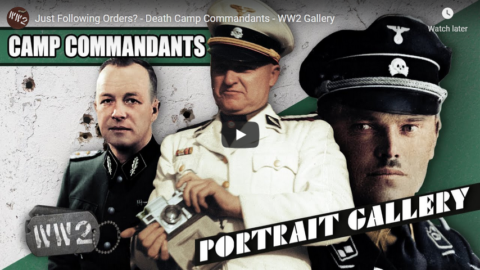World War Two
Published 2 Feb 2021All Nazi transit, concentration, labour and extermination camps were led by Nazi officers. In this episode, we’re taking a look at some of them to see what kind of people rose to those positions and what impact they made.
The video Spartacus mentions about how Eicke created the Concentration Camp model is here: https://youtu.be/SjLFdw5u26s
Join us on Patreon: https://www.patreon.com/TimeGhostHistory
Or join The TimeGhost Army directly at: https://timeghost.tvFollow WW2 day by day on Instagram @ww2_day_by_day – https://www.instagram.com/ww2_day_by_day
Between 2 Wars: https://www.youtube.com/playlist?list…
Source list: http://bit.ly/WW2sourcesHosted by: Spartacus Olsson
Written by: Joram Appel and Spartacus Olsson
Director: Astrid Deinhard
Producers: Astrid Deinhard and Spartacus Olsson
Executive Producers: Astrid Deinhard, Indy Neidell, Spartacus Olsson, Bodo Rittenauer
Creative Producer: Maria Kyhle
Post-Production Director: Wieke Kapteijns
Research by: Joram Appel
Edited by: Iryna Dulka
Sound design: Marek Kamiński
Map animations: Eastory (https://www.youtube.com/c/eastory)Colorizations by:
– Mikołaj Uchman
– Norman Stewart – https://oldtimesincolor.blogspot.com/Sources:
– United States Holocaust Memorial Museum
– Bundesarchiv: 152-01-14, 152-01-26, 152-01-024, 119-0052-01, 152-01-16, 183-W0402-503, 152-23-10A, 152-26-27, 183-78612-0004, 146-2007-0068, 152-23-21A
– Yad Vashem: 202_65, 202_71, 4613_666, 202_169, 202_167, 202_133, 192-093, 11CO3, 192-006, 11FO7, 1137_208
– Watchtower by Eliricon from the Noun ProjectSoundtracks from the Epidemic Sound:
– Gunnar Johnsen – “Not Safe Yet”
– Cobby Costa – “From the Past”
– Brightarm Orchestra – “On the Edge of Change”
– Phoenix Tail – “Last Minute Reaction”
– Christian Andersen – “Barrel”
– Farrell Wooten – “Rainy Landscapes”
– Flouw – “Endlessness”
– Wendel Scherer – “Defeated STEMS INSTRUMENTS”
– Craft Case – “Secret Cargo”Archive by Screenocean/Reuters https://www.screenocean.com.
A TimeGhost chronological documentary produced by OnLion Entertainment GmbH.
From the comments:
World War Two
5 hours ago (edited)
This is our first official “Gallery” episode. There are too many significant, impactful and interesting individuals to give them all their own Biography episodes. So we decided to bundle some of them together in categories in which they played a significant role, like the people who served as camp commandants in this episode. We will still do Biography specials when one individual story deserves to be told, but with the addition of this new format we will be able to cover a lot more and provide the broadest context to this immense war.







